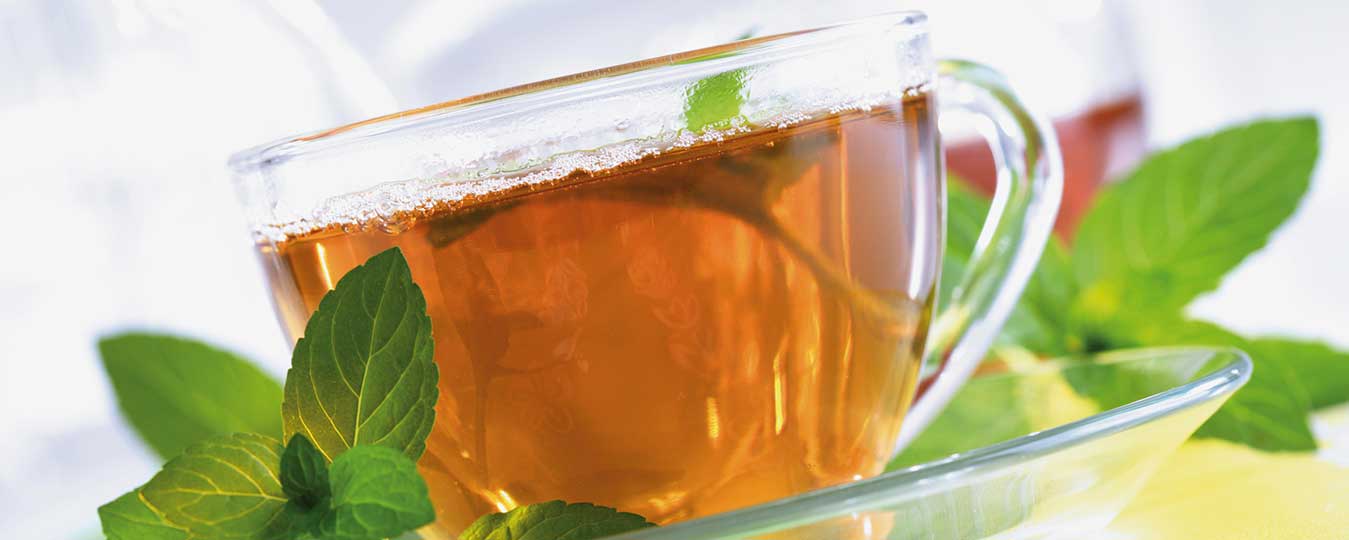Main Meals
Kiribath
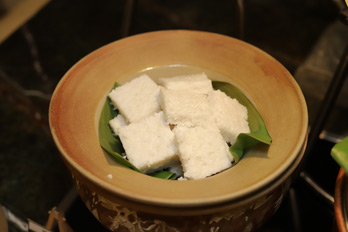
Kiribath or Milkrice is a traditional Sri Lankan meal which is made from rice. Kiribath is prepared by cooking rice with coconut milk. The name of “Kiribath” has originated as “Kiri” is referred for Milk and “Bath” is referred for “Rice”. Kiribath is considered as a meal which is served in every auspicious moment. For an example, Kiribath is added to the traditional food table of Sinhala Hindu New year. Also, Kiribath is the first solid food which is traditionally fed to an infant, and Kiribath is fed by bridegrooms to brides at Sinhalese traditional wedding ceremonies. Some people added Kiribath for their breakfast on the first day of each month. Kiribath is usually served with lunumiris which is made from red onions, chili flakes, salt, and lime. Further, Kiribath could be served with seeni sambol, jaggery and bananas.
String Hoppers
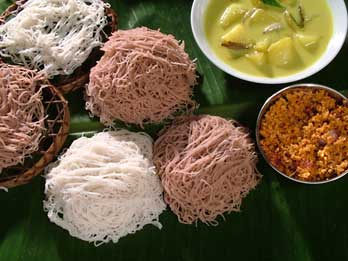
String Hoppers or Idiappa are normally served as a breakfast meal and as a dinner dish. String hoppers look like nests of spaghetti. String hoppers are prepared by mixing red or white roasted rice flour with water to make a dough, then push it through a sieve or press to make the strands. Then the matted nests are put into a steamer, and when it is cooked it is removed from the mats and are placed on a dish. Generally, String Hoppers are served with curry (Dhal, Potato, Fish, Meat) and pol sambol/coconut sambol (Made from coconut, chili pieces, onion).
Green gram
Green gram (Vigna radiata) is similarly known as Mung bean. Green gram is a small, round olive green bean with a sweet flavor and soft texture. Generally, Green gram is belonging to the Indian subcontinent, and it is commonly used in South-Asian cuisine. A bowl of boiled Green gram bean with coconut and a spicy lunumiris which is made with onion, chili pieces, salt and lime is a popular breakfast meal in Sri Lanka. It has high nutritional value as it contains protein, fiber, antioxidants and phytonutrients. Further, Green gram helps to lower high cholesterol levels, protect against heart disease and lower high blood pressure, and fight cancer development as it is a high source of vitamins and minerals.
Ibul Kiribath
Imbul Kiribath is a sweet variation of the Kiribath or Milk Rice which has cylindrical shape with a filling of Panipol in the center. Imbul Kiribath is made by taking a small amount of Kiribath, spreading it on a banana leaf or “Kolapatha” (Areca Sheath) and the filling called Panipol is placed in the center. Panipol is a sweet filling which is made of coconut and treacle. Then the banana leaf or “Kolapatha” is folded and rolled vertically and pressed firm to make it in to a cylindrical shape. Imbul Kiribath is served for breakfast or at tea time with bananas.
Coconut Roti

Coconut Roti or Pol Roti is a rustic flatbread made up of flour, grated coconut with diced green chili and onions for extra texture. The roti can be eaten with spicy spread or sweet spread, such as curry, sambol, lunumiris, butter and jam. Further, Coconut Roti could be served with jaggery and bananas. Generally, Coconut Roti is served as a breakfast or dinner meal, and also it could be taken as a tea time snack. Furthermore, Coconut Roti is famous as a street food in Sri Lanka.
Pittu
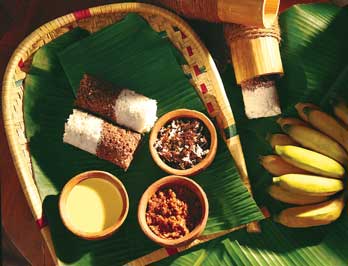
Pittu or funnel cakes which are made from flour (either rice of karukan) and fresh shredded coconut. Pittu are traditionally steamed in bamboo, and at present Pittu are steamed in circular metal tubes. After being cooked, the crumbly textured Pittu are served with fresh sweetened coconut milk. Sometimes, Pittu are served with lunumiris, jaggery and bananas. Generally, Pittu is served for breakfast, and sometimes it is eating for dinner also.
Finger Millet
Finger millet (Eleusine coracana) is an annual herbaceous plant widely grown as a cereal crop in the arid and semiarid areas in Africa and Asia, and it is one of important food crops in Sri Lanka. In Sri Lanka, finger millet is called as “Kurakkan”. In Sri Lanka Finger Millet or Kurakkan is used to make roti, congee, thalapa and helape (a kind of sweet roti). Kurakkan roti is made with nutritious finger millet flour, brown rice flour and freshly shredded coconut. It could be served with spicy lunumiris which made with onion, chilly pieces, salt and lime. Thallapa is a thick dough made of Kurakkan by boiling it with water and some salt until like a dough ball. Normally, Thallapa could be served with a spicy meat curry. Kurrakkan is a rich source of calcium, iron, protein, fiber and other minerals. Therefore, it has several medicinal and nutritional values, such as it helps to strengthening bones and helps to controlling blood sugar level in the condition of diabetes.
Rice and Curry
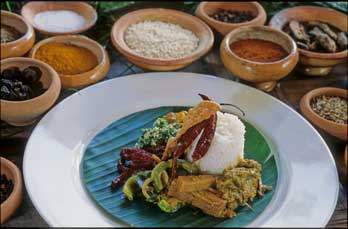
Rice and curry could be considered as the main meal of Sri Lanka. Most of Sri Lankans are having boiled rice and curry for their three main meals of breakfast, lunch and dinner. There are several varieties of rice produced in the paddy fields of Sri Lanka. They differ from the taste, size of grains, colour and smell. Also, there are several varieties of curries made from vegetables, meat and fish, various pickles, sambol, and papadum could be served alongside rice and curry dish.
Hoppers
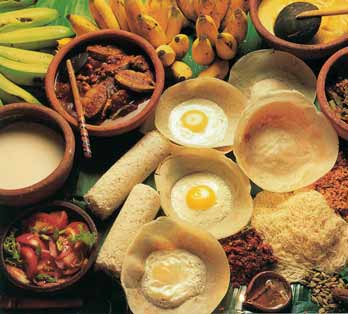
Hoppers are bowl-shaped pancakes made from fermented rice flour and coconut milk. It is cooked in a small round pans, they tend to come out crispy round the edges and thicker at the bottom. Generally, Plain hopper is served with lunumiris and a spicy curry, and plain hoppers are served with jaggery and bananas. Apart from that, there are several variations of Hoppers such as Egg hoppers, Honey hoppers. Plain hoppers and egg hoppers are served as a main meal for breakfast and dinner. Honey hoppers which have a sweet taste are also served for the breakfast. Further, hoppers are famous as a street food in Sri Lanka as it could be consumed as a tea time snack.
Kottu Roti
Kottu Roti is is a Sri Lankan dish made from godhamba roti (Godhamba roti is made from flour) and vegetables, egg and/or meat, and spices. There are several variations of Kottu Roti such as: Vegetable, Chicken, Cheese, Beef, Fish, Seafood and Mutton. Further, Dolphin Kottu is a new variant of Kottu Roti which is made from Parata, instead of godambha rotti. Apart from that, there is a Kottu Roti made from String hoppers, and it ia known as String hopper Kottu. Generally, Kottu Roti is served as a dinner dish, and it is very popular as a street food in Sri Lanka. When preparing a Kottu Roti a rhythmic tune can be heard as the Kottu chef uses two metal spatulas for mixing all the ingredients and cutting the stuff on the griddle with a rhythm.
Tempered rice
Tempered rice is made by mixing tempered onion, garlic, curry leaves, and cooked rice. Firstly, mustard seeds are added to heat oil in a pan, and after it splutters cumin seeds, splutter and peanuts are added. Thereafter it turns into golden brown when dried red chilli and curry leaves are added. Next, chopped garlic, chopped onion and turmeric powder are added. After that giving it a quick stir and cooked rice and salt are added. Some are adding butter as an alternative for oil. Generally, Tempered rice is served for lunch and dinner.
Side Dishes
Jackfruit
The jackfruit (Artocarpus heterophyllus) could be served in several ways such as: boiled jackfruit, jackfruit curry of kirikos, tender jackfruit curry (Polos) and kos mallum. There are lot of ways of cook Jack-fruit. Boiled jackfruit could be served with coconut or coconut sambol to eat with rice and curry. Jackfruit curry or kirikos is a creamy coconut milk curry which is made from mixing the Jackfruit, the seeds and all the other ingredients except the mustard and the coconut milk in a pan after lean and deseed Jackfruit, and cut the Jack-fruit into thin long stripes and cut the seeds into two pieces. Then usually a cup of water is added to it and it is stirred by putting the pan on a medium flame cover and cooking until the jackfruit is well-cooked. After that grinded mustard seeds are added and stirred it to the coconut milk. Finally, this is added to the pan and boiled to serve a delicious Jackfruit curry of kirikos. Tender jackfruit curry (Polos) is made by adding mustard seeds to hot oil and after that mustard seeds pop, adding onion, garlic, curry leaves, and green chilies are added. Then it is cooked until fragrant, by adding Tender jackfruit curry (Polos) pieces and the second extract of coconut milk. After that when tender jackfruit curry (Polos) pieces are almost fully cooked, rest of the coconut milk is added and it is cooked until the gravy thickens to serve the delicious tender jackfruit curry (Polos). Kos mallum or Jackfruit with coconut is made from cooking the mixture of boiled jack, grinded onion, green chilies, garlic, mustard seeds, curry leaves along with turmeric powder and salt, and scraped coconut.
Thibbatu
Thibbatu or Gonabatu is a native fruit in Sri Lanka, and its’ scientific name is Solanum torvum. In Sri Lanka Thibbatu is served with rice. Generally, Thibbatu is cooked as a Mallum. Thibbatu Mallum is made by adding chopped boiled Thibbatu and grinded ingredients of spices to heat oil. Then some scraped coconut are added in to it, and the mixture is cooked. Further, Thibbatu is uses for Ayurvedic treatment for Naso pharyngeal infections, Coughs, Pains, Oedema, Gout, Diarrhea, Dysentery, Fevers, Kidney stones, Urinary diseases, Skin diseases, Oral diseases as its fruits, leaves, root and seeds have medicinal value, and specially Thibbatu is considering as a Ayurvedic medicinal plant of Sri Lanka.
Papadam
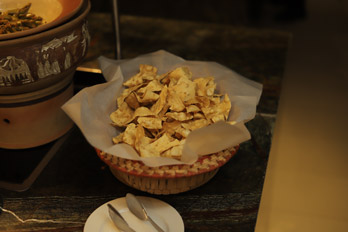
In Sri Lanka, Papadam is typically served as an appetizer to a meal of rice and curry. It is adding an extraordinary taste to the rice and curry dish. Sometimes Papadam is served with toppings such as chopped onions, chopped carrots and dry red chilies. Papadam is made from wheat flour, orid (Undu, Urad) flour, sodium bicarbonate, salt.
Kekiri
aaKekiri or cooking melon is a vegetable which is similar to cucumber or melon, and it is used to make delicious curry which could be served with rice. Kekiri curry is made by adding mustard seeds, ginger garlic and onion to heat oil and frying it until get brown color, then adding Kekiri pieces and all the other ingredients. After that the curry is cooked under low fire. aaa
Pumpkin
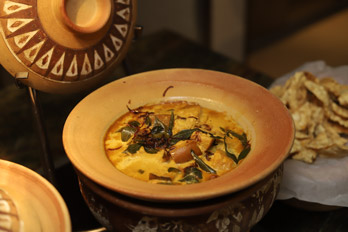
Pumpkin is a popular vegetable in Sri Lanka, and it is normally served as a delicious curry. It is mild spicy and cooked using green chili instead of red chili, and its’ appearance is yellowish. Moreover, Pumpkin could be served as a Pumpkin Kalu pol maluwa, which uses all spices and coconut after roasting till brown. The gravy of this curry is so thick and creamy due to grated coconut.
Nelum ala
Nelum ala or Lotus Stem (Nelumbo nucifera) is delicious side dish in Sri Lankan cuisine. It could be made as a Nelum ala curry and as a tempered Nelum ala. Nelum ala has medicinal and nutritional value which boosts immunity and aid in weight management, helps to improve health of skin, hair and eyes. gives relief from headaches and stress, simulating blood circulation, protests against cardiovascular diseases, facilitates digestion and regular bowel movements.
Coconut Sambal
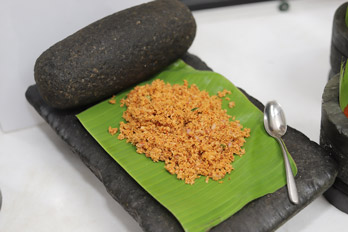
Coconut Sambal or Pol Sambola is a traditional Sri Lankan dish made from coconut, red onions, dried whole chilies or chili powder, lime juice, salt and or maldive fish. Generally, Coconut Sambal is used as an accompaniment with rice, string hoppers and bread.
Breadfruit
Breadfruit could be served in several ways such as: boiled Breadfruit, Breadfruit curry and Breadfruit mallum. Boiled Breadfruit could be served with coconut or coconut sambol to eat with rice and curry. Breadfruit curry is a creamy coconut milk curry which is made by mixing the Breadfruit, and all the other ingredients except the mustard and the coconut milk in a pan after lean and deseed Breadfruit, and cut the Breadfruit into pieces. Then a cup of water is added to it and stirred, and it is put in to the pan on a medium flame cover and is cooked until the Breadfruit is well-cooked. After that grinded mustard seeds are added and stirring it with the coconut milk. Finally, this is added to the pan and brought to boil to serve a delicious Breadfruit curry. Breadfruit mallum or Breadfruit with coconut is made from cooking the mixture of boiled Breadfruit, grinded onion, green chilies, garlic, mustard seeds, curry leaves along with turmeric powder and salt, and scraped coconut.
Ladies Fingers
Ladies Fingers or Okra are served as a side dish in Sri Lankan cuisine. Normally, fresh and crunchy Ladies Fingers are used to cook for get authentic taste. It has rich nutritional value. Ladies Fingers are served as devilled Ladies Fingers or Ladies Fingers salad or Ladies Fingers curry. Ladies Fingers have high nutritional value as its’ contains healthful vitamins and minerals.
Dhal

Dhal curry is one of the most usually consumed staple dishes in Sri Lankan cuisine. Dhal could be served as a milky dhal curry or spicy dhal curry or tempered dhal curry. The Dhal, usually masoor dhal which are red lentils, are often cooked in a blend of spices and coconut milk. Dhal curry is served with many main meals such as; rice and curry, string hoppers, noodles.
Keselmuwa
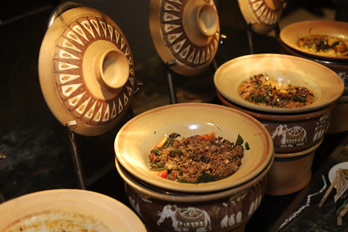
Keselmuwa or Banana flower is a tasty side dish which is served with rice and curry meal in Sri Lanka. Banana flower is also known as a banana blossom or heart. It could be served as a Keselmuwa curry or Keselmuwa pickle or tempered Keselmuwa. Keselmuwa is one of the highly nutritious parts of Banana tree as it is a rich source of vitamin A and vitamin C. Further, it is a common ingredient in Ayurvedic cooking and it is helps to heal menstrual pain.
Spices
Cinnamon
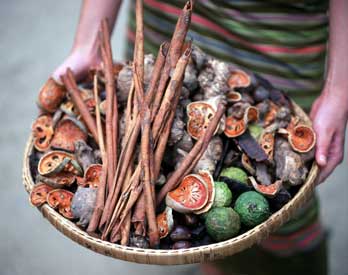
Popular among the world for the distinct flavor of the spice, which is sweet and delicate, “Ceylon Cinnamon” is crowned as the “king” of spices. Scientifically known as “Cinamomum Zeylanicum Blume”, Ceylon cinnamon varies from cassia in different ways. Especially the taste and the aroma is way different in Ceylon Cinnamon from cassia. Cinnamon is known not only because it is the oldest known spice, but also because it is great for the health. Cinnamon protects people from the medical conditions regarding the brain or nervous system. Several such diseases are Parkinson’s disease or Alzheimer’s disease. Moreover, cinnamon fights against bacteria. It is well known for low calories and sugar-free nature. Ceylon Cinnamon is used as a spice to be added for the desserts and for lighter dishes because of its comparatively delicate flavor. Furthermore, it is mentioned by the health experts that Cinnamon helps you to lose weight, improve memory and slower the blood clotting rate.
Black Pepper
Black Pepper which is scientifically known as “Piper nigrum” is Used both as a medicine and a spice. In Sri Lanka, Black pepper is a readily available spice in any household. It is often said that Black pepper helps in weight loss. Moreover, it is believed that Black Pepper reduces the risk of cancer, and heart and liver ailments. For a long period of time, black pepper is used to preserve food due to its antibacterial properties. Since black pepper is rich in minerals such as potassium and calcium, it serves as an anti-inflammatory agent. Moreover, black pepper aids to improve digestion and to treat asthma, sinus and nasal congestion.
Nutmeg
Another type of spices available in Sri Lanka, “Nutmeg” is a popular flavor specially used in baking and to make beverages. Especially Nutmeg is used with hearty dishes such as lamb and mutton recipes and vegetable stews. Nutmeg comes from Nutmeg tree which is scientifically known as “Myristica fragrans”. Nutmeg specially aids to add both a sweet and a savory taste in the food you make. It has a warm and a spicy aroma. Nutmeg can be used to create Mostly used to scent soaps and perfumes. Additionally, ointment of nutmeg can be used as a treatment of rheumatism as well. Nutmeg helps to relieve pain as well to reduce insomnia
Cardamom
Scientifically known as “Elettaria cardamomum”, Cardamom is one of the spices that are used specially to soothe an upset stomach. It is available in both sweet and savory flavors. Cardamom is high in minerals like magnesium and zinc. Having a light lemon flavor, cardamom is being used as a whole pod or the seeds of the cardamom can be made it to a powder. Cardamom is well known to fight inflammation and lower the blood pressure. What is special about Cardamom is the power it holds to prevent the growth of the cancer cells. Nonetheless, Cardamom aids in digestion process too. Especially, it can heal ulcers.
Areca nut
Areca-nut, which is often used in Sri Lanka along with the betel leaf to chew, is the fruit of the areca palm is both used in fresh and dry forms. It is also used in the traditional Chinese medicine. Areca nut provides a mild stimulant which provides mild hot sensation to the body. Moreover, areca nut is used in the veterinary medicine to remove tapeworms and other intestinal parasites of animals. Another major use of Areca nut is that it can be used against certain skin diseases. Additionally, it can be also used in the metabolic system as a digestive and carminative Anti-diabetic.
Cloves
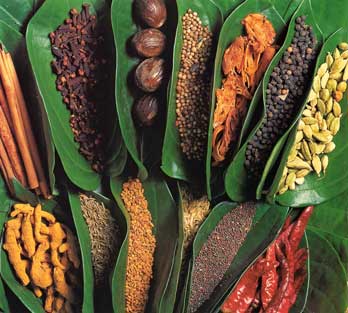
Cloves are used as spices as well as medications. They are aromatic flower buds and are often found in the manufacturing of toothpaste, cosmetics, soaps, and, perfumes. One of the major medicinal value of cloves is to slow down the blood clotting. Moreover, cloves can treat acne, aiding the youthful skin. Nevertheless, cloves can be applied to minor cuts for healing purposes. Since clove includes of carbohydrates, protein, energy, minerals and dietary fiber, it is especially used when cooking meats and curries. Cloves provide an aesthetic appeal and are used as food flavouring as well. Additionally, Cloves contain chemicals which help to decrease pain and fight infections.
Mace
Though known as a spice, “mace” is not much popular as a spice like the nutmeg. However, the lacy covering of the nutmeg. It is bright red and is a seed shell which has a sweet fragrance. It is often said that the mace cannot be cooked for long as it gives a bitter taste. Therefore, it is advised to add mace towards the end of the cooking. The mace blades, which are located outside the mace can be removed and dried for culinary purposes. With respect to the taste, though it is much similar to the taste of the nutmeg, mostly, mace is delicate in taste. Mace is mainly used to make baked goods, meat and stews since it is a savory spice.
Fruits
Cashew Apple
Cashew Apple, which is known to be a tropical fruit which can be seen in Sri Lanka. The apple of the fruit is consumed when it is fresh and it has a sweet taste. Yet the nut is consumed separately and it is what which is called as “cashew”. In Sri Lanka, cashew nut curries are prepared alongside the main dishes.
Atemoya
Atemoya which is also known as “Katu Anoda” amongst the Sri Lankans, is widely popular not only for the flavor but also for the medicinal value of it possesses. It is ideal for consumption for sicknesses such as Hypertension, Diarrhoea, Depression, Dysentery, Hair Lice, Naso-pharyngeal infections, Malignancies, Fevers, and Constipation. It doesn’t need seasoning and can be used to make juice as well.
Mango
A nutritional tropical fruit found in Asia, Mango is known to be the “king of fruits” for its delicious taste. There are various types of Mango that has several flavours. This fruit has medicinal value since it rich in fiber, vitamins and minerals. It is believed by the scientists that mangos are known to offer protection against breast and colon cancers, leukemia and prostate cancers.
Pomegranate
High in the medicinal value, pomegranate too is known to be a tropical plant growing in Sri Lanka. Sri Lankan variety of pomegranate is very sour compared to the sweet taste of Indian pomegranates. Pomegranate is way rich in fiber, vitamins and minerals, but they also contain some sugar. It is said that young pomegranate leaves can be used for the cleaning and washing of eyes in eye infections after boiling in water. Some other medicinal values of pomegranate are: lowering blood pressure, helping to fight arthritis and joint pain and lowering the risk of heart disease.
Jack fruit
A fruit that is abundantly grown in Sri Lanka is the “jack fruit”, which is known to be the largest fruit in the world. When jackfruit is ripe, it is considered as a fruit and it has a sweet flavor. The immature fruits can be used to make Sri Lankan jackfruit curry.
Banana
The most frequently found fruit in Sri Lanka, “banana”, is known to be a fruit most Sri Lankans eat daily. Rich in the nutritional value, banana or “kesel” in Sinhalese has many varieities, depending on the flavor. Some of them are: “ambul kesel”, “Seeni kesel”, “rath kesel” etc. Banana reduces the risk of asthma and cancer.
Carambola
“Carambola”, which is a fruit with a citrus like taste is grown in Sri Lanka and is known as “Kamaranka”. This could be consumed fresh or even consume as juices. Specific to Asia, the fruit as various medicinal values such as relieving cough and rheumatism. The leaves of Carambola can be added to salads and it has an acid-flavour.
Avocado
Avocado, which is one of the healthiest fruits, is widely grown in Sri Lanka. Avocado is rich in nutrients and has various medicinal values such as it is healthy for the heart and is good to improve vision. Avocado contains fiber which helps weight loss. Moreover, it is believed that consuming avocado lowers the risk of getting high cholesterol levels.
Passion fruit
Low on calories yet high in nutrients, passion fruit is originated in Latin America. It is the fruit of the Passiflora vine. Available in Sri Lanka is the yellow variant of passion fruit. This fruit has a tough outer rind and juicy, seed-filled center. Passion fruit is a rich source for antioxidants. Moreover, it consists of dietary fiber.
Sapodilla
Abundant in nutrients, vitamins, minerals, glucose, tannins and calories, Sapodilla is a healthy tropical fruit which is high in antioxidant rich vitamin C. Thus, Sapodilla has a medicinal value, especially in various metabolic processes in the body. It is believed that since Sapodilla contains fiber, it helps to relieve constipation protect the colon from cancer-causing toxins. Moreover, this is good for digestion process too.
Guava
Indeed, a soothing and a refreshing fruit that quenches the thirst, Guava is sourness combined with a sweetness. Guava can be taken either as a fruit or guava juice could be made. There are various varieties of Guava such as “Kilo Guava” (Kilo pera). Guava is oval and round and has the shape of a pear. Guava is Rich in vitamins such as A and C, dietary fiber and minerals.
Rambutan
A fruit that is red in colour, “rambutan” is tropical fruit that is golf-ball sized. Rich in nutrients and antioxidants, rambutan contains a good amount of copper which is good for the growth of cells and bones. Due to the fiber content, rambutan aids digestion. In addition, it may aids weight loss too.
King Coconut
The first fruit had by most of the tourists who visited Sri Lanka should be “king coconut”, for it is known to be a fruit that quenches thirst. It is locally called as “Thambili” has a bright orange colour. Ranging from the star hotels to street side vendors, Thambili is sold. It is very nutritious drink and the fruit looks like the orange version of coconut.
Cacao
Cacao or Cocoa, which mainly has seeds to produce various flavours of Chocolates, is grown in Sri Lanka. The flesh of cocoa can be consumed as a dessert whereas the seeds are mostly used to make chocolates. Raw Cacao possess medicinal values such as mitigating hyper tension and reduces inflammation. Since Cacao is also known as a “love drug”, it can be said that Cacao is very much helpful in fixing the mood.
Breadfruit
When it ripen, breadfruit may be eaten as a fruit and if it is not ripen, it can be eaten as a vegetable. It is believed that the breadfruit leaf can lower blood pressure, and relieve asthma. This fruit is very rich in nutrients such as fiber, calcium and iron.
Pineapple
Most of the tourists visiting Sri Lanka seeks for the fruit Pineapple, since it is widely available in Sri Lanka. Pineapple is consumed in various ways such as: a fruit, a juice or alongside rice and curry as a dish. The fruit is believed to be very refreshing. This tropical fruit has a sweet and tangy flavor.
Sugar Apple
Known as “Katu aththa” in Sri Lanka, the fruit of Annona squamosa, can be found in Sri Lankan Supermarkets as a tropical fruit. Various parts of Katu Aththa are used for treatments. They are: bark, leaves, fruits, flowers and roots. In Sri Lankan Ayurvedic Medicine, Sugar apple is used as an antidote with antibacterial properties.
Jambu
Jambu is also used as an effective way to reduce blood sugar levels. Moreover, it is believed that Jambu helps to improve vision. The leaf of Jambu is used treat cracked tongues, coughs and headaches. It is also known from various names such as “Wax Apple”, “The Water Apple” and “The Rose Apple”.
Mangosteen
Mangoosteen is another tropical fruit which is abundantly found in the island nation: “Sri Lanka”. Scientifically known as “arcinia mangostana”, Mangoosteen is an exotic, tropical fruit, It is has sweet and sour flavor and is deep purple in colour. Since Mangoosteen is rich in nutrients, fiber, and unique antioxidants, it has various health benefits. Mangoosteen has anti-inflammatory properties as well.
Sweets
Kevum
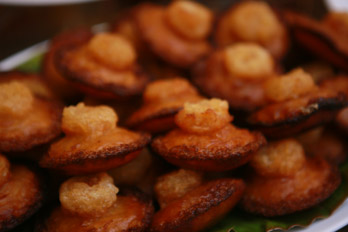
An integral sweet which can be found in the traditional sweets table in Sri Lanka is “Kewum” which is also called by some as “Oil cake”. It is made from rice flour and kithul (sugar-palm) treacle and various other ingredients. It is needed to practice the mastery to make this deep fried food. There are various varieties of Kawum such as: Konda Kawum, Mung (Gram) Kawum, Naran (Mandarin) Kawum, Thala (Sesame) Kewum etc.
Kokis
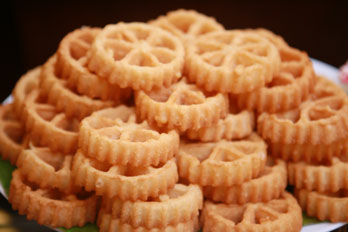
Kokis is a crispy sweet found as an essential in the Sinhala and Tamil New Year sweets table. It is also deep fried and is made from rice flour and coconut milk. It is believed to have come from the Dutch and is made in different shapes depends on the mold such as flowers, butterfly etc. Kokis can be served either when it is hot or when it is cool down.
Asmi
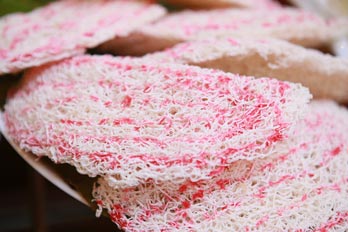
“Asmi” which is another sweet in the traditional food table of Sri Lanka, is known for the web-like design of the sweet. The batter of the sweet is way unique and it is made by adding rice flour and coconut milk. For decorating the sweet, thick sugary syrup is needed. Mastery is needed to make sweets like asmi.
Kalu Dodol
A keeper on any festive table or simply to satisfy your sweet tooth, the dark and sticky dish – “kalu dodol” is believed to be inherited to Sri Lankan community from the Malay immigrants. It is made mainly of kithul jaggery (from the sap of the toddy palm), rice flour and coconut milk. In Sri Lanka, Hambanthota area is famous for the production of Kalu dodol.
Aluwa
Another famous sweet in Sri Lanka is “Aluwa”, which is often made by adding treacle or sugar. It is really delicious since it is inclusive of ingredients such as rice flour, cardamom and cashew nuts. Aluwa is also known as “Kadju Aluwa” (Cashew Aluwa) when cashew are added with aluwa. This is a very famous sweet amongst the Sri Lankans as well as foreign tourists.
Pani Walalu
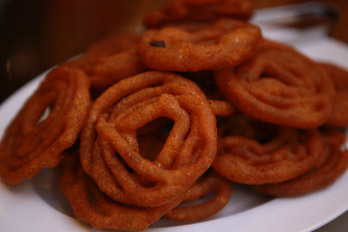
This is undoubtedly the most sought after sweet in the Sri Lankan traditional food table since it is really delicious and yummy. It is covered in layers of honey and is also known as “Udu Walalu.” It is made by using undu flour and rice flour and soaking in kithul treacle. When making Pani Walalu the gram and the rice flour mixture is soaked in treacle.
Rulan
Rulan is another famous sweet in Sri Lanka and can be often found in auspicious ceremonies and Sinhala and Tamil New year celebrations. It is made using sugar, cardamom, coconut etc. Later, when the batter is well heated and stirred, it could be cut in to a preferred shape. Usually it is square shaped.
Weli Thalapa
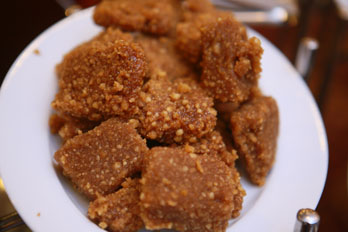
Guaranteed to delight your taste buds with every bite, “Weli Thalapa” is another integral dish in the Sri Lankan traditional sweet table. Thus, weli thalapa makes an appearance at Sinhala and Tamil New Year. Weli Thalapa is prepared with rice flour and coconut treacle too is added. In order to make this dish, coconut, sugar and cardamom can be added too.
Bibikkan
Made from coconut treacle, grams and other ingredients, “Bibikkan” is an authentic traditional cake which is flavoured with an amazing blend of Sri Lanka's finest spices. It satisfies the sweet tooth and is a dark traditional sweet which is sticky and moist. It is believed that the origins in the sweet dates back to the Portuguese era.
Milk Toffee
Milk toffee is a popular sweet in the island and it is really delicious. It is said that the origin of milk toffees runs back to the time of the British, as a reminiscent of the English toffees. Although the size may differ according to the occasion, this sweet is made by adding sweetened condensed milk, sugar, cashews and if preferred – cardamom too.
Aggala
A healthy sweet that could be found in Sri Lanka is “Aggala”. It is not that sweet as the other sweets and that is one reason why many people prefer Aggala. It is made from jaggery, coconut, flour, pepper and water and are made in to balls at the end. Later it is coated with flour.
Muscut
Muscut is a sweet delicacy that has its roots in India. Either we can make it with coconut milk and coconut oil, or with ghee and vegetable oil. Mostly, food colours are added to muscut to get different colours, such as yellow and red. Muscut is known to be a sticky sweet.
Boondi
Boondi is a sweet that has the origin in India, is a fried chickpea flour sweet. It is popular in Sri Lanka too and it comes in colours such as bright red and crimson. It is a sugary dessert and hence, it is popular among those who have sweet tooth.
Watalappan
Watalppan, a delicious sweet in Sri Lanka is often served as a dessert in the buffets as well. Mostly, it is popular among the Muslim community. Thus, it is widely believed that the dish has a Malay origin. It is made using coconut milk, eggs, kithul jaggery, brown sugar, nutmeg etc. If preferred, cashew can be added too.
Buffalo Curd
Buffalo curd can be found across the country and usually it is taken either with treacle or sugar. Usually, buffalo curd is served in clay pots. Buffalo curd is thicker and tastier and has a higher fat content since it is made from filtered and boiled buffalo milk. The curd made in Tissamaharama district is very popular.
Helapa
The Sri Lankan sweet wrapped in a leaf is known as “Helapa” and it is consumed alongside a cup of tea as well. It is made using jaggery can be taken as a snack with coffee too. Other ingredients used for making “Helapa” are: Steamed All-Purpose Flour, Kurakkan/Finger Millet Flour and Coconut.
Beverages
Saruwath
If you catch a colourful beverage in bright red, hot pink or yellow in the streets in Sri Lanka, that is the drink known to be “Saruwath”. This is made using ingredients such as oranges, kasa kasa seeds, sugar syrup, pineapple and papaya, salt and ice. Saruwath is a very refreshing drink which has a chilling effect.
Tea
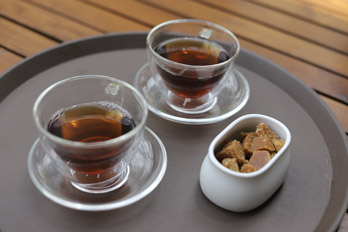
Sri Lanka, the island nation popular for its tea production across the globe is indeed the home to sip a cup of tea. There are dozens of tea flavours available. Depending on your requirement, you are given the chance to select the tea you like – ranging from green tea to black tea. Known as “Ceylon Tea” across the world, Sri Lanka houses tea museums for visits as well. Moreover, the visitors are allowed to visit some tea factories in order to understand how the tea is processed.
Milk Tea
Known as “Tea Latte”, Sri Lankan Milk Tea is a widely popular beverage. Usually, Sri Lankans are known to have milk tea every day, in morning and in evenings. Even the milk tea is made with steamed milk, which are mixed with tea. Either Soy Milk, Cow’s Milk or Almond Milk could be used there based on your preference.
Coriander Tea
Scientifically known as “Coriandrum sativum”, Coriander is also called as “Chinese Parsley”.Sri Lankans call coriander as “Koththamalli” and it is much popular as a herbal drink.Especially when a person is down with flu, Sri Lankans make the coriander tea as it is well known to heal cough and sneezing. It is also mentioned that this beverage supports to cleanse body of toxins and to aid in healthy digestion. Additionally, it is believed that the antioxidant properties of coriander are perfect to clear up skin disorders such as eczema, dryness, and fungal infections. In order to make Coriander tea – Coriander seeds and sliced ginger are added to water and they are boiled together for few minutes.
Belimal
“Belimal”, a herbal drink that can be found in Sri Lanka, is widely known for the medicinal value it possesses. This fruit which is known to have more nutrients is said to be indigenous to Sri Lanka. Beli-mal, which is a hot beverage is boiled for longer in order to gain a better taste. It aids to cool down the body. Usually beverage is a bitter in taste, consumers usually have beli-mal with jaggery.
Suwendel
Suwandel rice is an indigenous white rice variety with an exquisite aroma and it is a short round variety of rice. Cooked rice of Suwedel has a milky taste, and appearance of cooked rice is higher than other traditional verities of rice. Therefore, this rice variety is good for serving at festival occasions and ceremonies. Suwendel contains more carbohydrate, vitamin, fat and micro nutrients. This rice variety helps to control diabetes and it is reducing high blood pressure while inducing the nerve system of the human body, specially the nerve cells connected to the eyes and the brain.
Coffee
In Sri Lanka, various types of coffee are available, from the star hotels to the street shops. Varieties such as Capuccino, Espresso, Caffè macchiato and Caffè mocha are readily available in Sri Lanka. Since the British had started growing cofee plants in Sri Lanka, Coffee had been a major economic crop. Yet, laterin the 19th Century Sri Lanka endured an epidemic of coffee leaf fungus which destroyed most of the plantations.
Kenda
A traditional and a nutritional beverage, Kenda (Which is also known as Kanji or Porridge) is tasted by many in Sri Lanka. Kola Kenda is usually made using rice, herbs and coconut milk.Various herbs can be added to make Kola Kenda and this includes: Gotukola (Pennywort), Erabadu (Erythrina Variegetalt/Coral Tree), Karapincha (Curry Leaves), Mukunuwenna (Alternanthera Sessilis/Ponnanganni), Polpala (Aerva Lanata), Neeramulliya (Hygrophila), Kohila (Lasia Spinosa), Hathawariya (Asparagus), Panela, and Eramusu (Hemidesmus Indicus/Nannari). It is said that the nutritional impact of Kola Kenda aids in improving the digestive process. Additionally, it helps to rejuvenate the system and cure illnesses.
Rice
Rath Suwendel
Rath Suwendel is a traditional rice variety with medium red colour grain. This rice variety could be cultivated in both Dry zone and Wet zone in Sri Lanka. As Rath Suwendel has fragrance this rice varietyis is used to make milk rice. This rice variety has herbal value as Indigenous doctors used Rath Suwendel for treating diabetes and oxidative stress. Further, Rath Suwendel contains high amount of protein and zinc.
Rath el
Rath el produces small size grains with white colour pericarp. Cooked rice of Rath el may have dull colour. However, this is slightly tasty and sticky. This rice variety is suitable to control cirrhosis, virus fever, skin rashes, diabetes, diseases in urinary system and prevents the formation of stones in the urinary system. Further, this rice variety is recommended for patients who are suffering fever and diabetes.
Pachchaperumal
Pachchaperumal is a rice variety with red colour short grain. The word “Pachchaperumal” means the Lord Buddhas’ complexion. Therefore, it has been considered a divine rice variety in the traditional Sinhalese culture. Pachchaperumal rice variety contains proteins, vitamins, micro nutrients and the grain is rich in antioxidant agents. Pachchaperumal is good for diabetes and cardiovascular diseases like high blood pressure. Further, this rice variety helps to cool the body, increases the production of insulin and reduces the production of thyroxin in the body. Furthermore, Pachchaperumal rice variety helps for proper functioning of the excretory system and production of some enzymes and hormones which are needed for the development of red blood cells. As Pachchaperumal rice variety is rich in nutrients and proteins it is good for feed to children.
Batapola el
Batapla el is a rice variety with red colour medium size grain. This rice variety is generally cultivated in paddy fields at Wet zone of Sri Lanka.
Madathawalu
Madathawalu is a rice variety with bold red grains, and it could be cultivated in all the districts of Sri Lanka. This rice variety is suitable for cultivation in Maha season at muddy rice fields. The content of protein, minerals and fat of Madathawalu are comparatively higher than most of other varieties, and it has large amount of iron, zinc, potassium and antioxidants. As there are several medicinal and nutritional qualities Madathawalu rice is important to treat diabetes and oxidative stress. Madathawalu rice variety is able to remove toxic components, specially some cancer agents from the human body. Further, Madathawalu rice variety is important to clean the blood circulation system, promote the activity of sweating glands and increase the immune system and it is suitable to feed infants and lactating mothers.
Rathdel
Rathdel is a red rice variety with tasty. This is recommended for health activity of the urinary system and is important to flush toxic excretory matter and cools the body. Further, Rathdel rice variety is suitable for cirrhosis, skin disease like rashes, tuberculosis and lung diseases. As Rathdel has medicinal and nutritional value, the viral diseases could be prevented by porridge or soup of Rathdel.
Maa-Wee
There are sub varieties of Maa-Wee, such as Kuru Maa-Wee, Baala Maa-Wee, Maha Maa-Wee, Sudu Maa-Wee, Kalu bala Maa-Wee and Palatuwa Maa-Wee. Maa-Wee varieties are generally cultivated in Wet and Intermediate zones of Sri Lanka, and could be harvested only in Maha season. Grain of Maa-Wee is in maroon colour. Rice varieties of Maa-Wee are considered as heavy diet which digests slowly. Maa-Wee has comparatively high iron and zinc content, and high levels of protein and antioxidants. Maa-Wee varieties are normally used in orthopedic treatments in Ayruveda medicine as all these varieties have high nutritional and medicinal value. “Baala Maa-Wee”is specially used in the treatments for gangrene, jaundice and obesity as its’ helps to cool the human body. Further, it is recommended for lactating mothers.
Herath banda
Herath banda is a very popular variety of rice growing in Wet Zone of Sri Lanka. Cooked rice of this variety is slightly tasty and non - sticky. Traditional doctors recommend this rice variety for improvement of the immunity of the human body.
Masuran
Masuran is a medium size red rice variety which is suitable to cultivate in Wet zone of Sri Lanka. There is a belief that the name “Masuran” was derived based on the medicinal importance of the variety as “Masuran” is the word on Sinhala used to explain most valuable things. Masuran rice variety is useful for preventing and treating diabetes, inflammations, cancer and neurological disease patients. Further, this rice variety is good for reducig cholesterol level of the body and oxidative stress.
Dahanala
Dahanala is a type of long-grained red rice which is being cultivated in Wet zone of Sri Lanka. This rice variety is rich in protein, zinc and iron. Dahanala is prescribed for lactating and expecting mothers, patients with diarrhea and hepatitis. Further, this rice variety is good to control diabetes, and it helps to reduce the mental depression. Dahanala rice variety is used for preparing congee and porridge
Kalu heenati
Kalu heenati is a red rice variety with fine grain. Also, Kalu heenati is a dark colour rice variety, and its’ Sinhala name of “Kalu” is similar to English word of “Black”. This rice variety is suitable for dry zone of Sri Lanka as it is not suitable for puddle muddy paddy lands. Palatability of cooked rice of Kalu heenati is rather low. This has high nutritional value, and it contains minerals and micro nutrients including high iron and zinc content. Kalu heenati is good for daily consumption and lactating mothers. Further, Kalu heenati enhances immunity and physical strength and it is use for treatment for snake bite, cholesterol and hepatitis.
Beheth heenati
Beheth heenati is a rice variety with short round type grains. This rice variety is mostly suitable for muddy puddle soil. Therefore, Beheth heenati rice variety is popular in South-West region of Sri Lanka. According to the name of “Beheth heenati” it includes about medicinal value of this rice variety as the Sinhala word of “Beheth” is similar to the English word of “Medicine”. Generally, congee made by Beheth heenati rice variety is good for removing snake toxins and for diabetes patients.
Rathu heenati
Rathu heenati is a red rice variety with medium size grains. This rice variety could be cultivated in both Yala and Maha seasons, and it is suitable to cultivated in all the parts of Sri Lanka. Cooked rice of Rathu heenati is slightly sticky, and tasty. Grain of Rathu heenati is rich in iron, zinc and natural antioxidants, and it could be used to treat hepatitis and diarrhea patients. This is good for the first meal of infants. Further, Rathu heenati rice variety is good for expecting mothers.
Sudu heenati
Sudu heenati is a rice variety with bold red grain and light straw colored hull. This rice variety could be cultivated in all the parts of Sri Lanka. Cooked rice of Sudu heenati is slightly sticky and tasty. Sudu Heenati has rich nutritional and medicinal value as it conrains vitamin E, high iron, high zinc and other natural antioxidants. Therefore, this rice variety is suitable for treating inflammations, diabetes, cancer, neurological diseases, cholesterol, constipation and oxidative stress. Further, Sudu heenati helps to enhance the human immune system.
Goda heenati
Goda heenati is a rice variety with medium grains in brownish red colour. Cooked rice of Goda heenati is not very tasty like other rice varieties. In the past, farmers believe that Goda heenati is suitable for higher elevations, and at present it is cultivated in all the parts of Sri Lanka except iron toxic rice fields. This rice variety is rich in proteins, zinc, vitamin E and natural antioxidants. Goda heenati could be developed immunity in the human body, and it could be used to treat patients suffering from inflammations, diabetes, neurological diseases, cholesterol and oxidative stress.
Dik wee
Dik wee is a rice variety with medium size red grain. The name of “Dik wee” is given due to its’ lengthiness of seeds. Generally, this rice variety is cultivated in Wet zone of Sri Lanka. Dik wee contains high level of zinc and natural antioxidants. This is good for the treatments of gangrene, jaundice, inflammations, diabetes, cancer, neurological diseases, high cholesterol and oxidative stress. Moreover, Dik wee rice variety is highly recommended for expecting mothers as it has high nutritional value.
Hatada wee
Hatada wee is a short duration rice variety which could be harvested within 70 days. Hatada wee helps to control diabetes, blood vomiting, internal hemorrhage in the human body. Hatada wee is good to increase the body strength and helps to reduce the body pains. Also, intake of rice cools the human body, and this rice variety is categorized as a low GI food based on scientific research.
Deveraddari
Deveraddari is a highly suitable rice variety for rice fields affected by flash floods and muddy soils. This rice variety is popular in Galle, Matara, Kalutara and Rathnapura districts of Sri Lanka. Deveraddari grain has high amount of zinc, and this rice variety is good for improvement the immune system of the human body.
Kahata wee
Kahata wee is a rice variety which could be cultivated in sandy and high iron bearing soils. The grain of Kahata wee is medium size and red in colour. Kahata rice variety is enriched in high amount of zinc and natural antioxidants. Further Kahata wee has medicinal and nutritional value as it improves the immune system of human body.
Suduru samba
Suduru samba is an ultra-short round or very small samba type of white grains. Cooked rice of Suduru samba is aromatic and non-sticky. Further cooked rice of Suduru samba has good taste. This is one of short period sensitive variety which can be harvested within 4 months in Maha season but it takes only 4½ months for harvesting in Yala season.
Suwnda samba
Suwnda samba is a rice variety with short round grains of red colour. Cooked rice of Suwnda samba is aromatic and tasty. However, cooked rice is slightly hard in texture.
Gonabaru
Gonabaru is medium size grain with red pericarp, and Gonabaru is a very rare old variety of red rice. This rice variety could be cultivated in both Wet and Dry zone of Sri Lanka. Cooked rice of Gonabaru is non sticky and slightly tasty. Especially, this rice variety is used for preparing “Habala pethi” as it has high medicinal and nutritional value which is able to develop immunity of the human body. Further, Gonabaru rice variety is used for treating diabetes and oxidative stress.
Murungakayan
Murungakayan is a rice variety with medium size and white colour grains. This rice variety could be cultivated in both Yala and Maha season, and it is popular in North Central province of Sri Lanka. Murungakayan rice variety is used as a remedy for gangrene, jaundice and good for expecting mothers as it has high nutritional value enhances the growth of the foetus and useful for the mother at her confinement.
Pokkali
Pokkali is a rice variety with bold red grains. Pokkali is cultivated in saline affected rice fields located at south western coastal belt and concentrated to Hambantota, Matara, Galle, Kalutara, Colombo and Puttalam districts of Sri Lanka. This rice variety has medicinal and nutritional qualities, and this grain is rich in protein. Further, Pokkali rice variety has high content of iron, zinc, potassium and antioxidants, and it helps to treat various diseases. Especially, this could be used as medicine to treat oxidative stress. Furthermore, indigenous doctors believe that Pokkali rice variety has antibacterial effect.
Kuruluthuda
Kuruluthuda is a highly nourished and Red long grains rice variety. This rice variety could be cultivated in both flash flood and salinity condition. Kuruluthuda contains high protein, fiber and necessary fatty acids. Cooked rice of Kuruluthuda has a pleasant taste. This rice variety has many medicinal and nutritional qualities. It provides comparatively high energy. Further, Kuruluthuda rice variety is recommended for consumption of people having high cholesterol in the blood.
Sulai
Sulai grows in boggy and muddy rice fields. This rice variety is popular in Galle, Matara, Kalutara and Rathnapura districts of Sri Lanka. Sulai has several nutrients which could be developed immunity of the human body.

